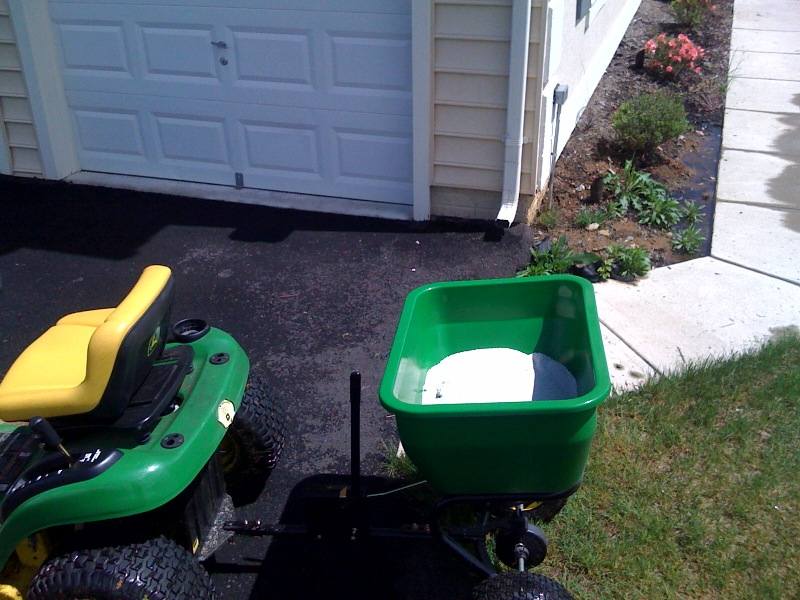Spring is great in New York. In fact, late spring is the best time to visit the state and certainly one of the best times to live here. But spring is also the time of the year when your yard needs your attention again, and doing it right will give your lawn the foundation it needs to thrive all year long.
Location matters, so the approach will be slightly different if you live in the cooler upstate area than along the Atlantic coast. But, in general, these 11 spring lawn care tips for New York will set you up well for the warm-weather months ahead.
In this article:
- Rake
- Test Your Soil
- Treat Lawn Diseases
- Fertilize
- Remove Weeds
- Eliminate Pests
- Check Your Lawn Equipment
- Dethatch, Only if Necessary
- Aerate
- Mow
- Water
1. Rake

Photo Credit: David Goehring / Wikimedia Commons / CC BY 2.0
As soon as spring starts, grab your rake and remove dead leaves, twigs and loose grass to help the lawn breathe. If the soil is moist, it’s best to wait for it to dry, as raking when wet can pull up healthy grass.
Raking promotes straight grass growth by splitting grass blades. After your first rake, you can let thatch build up to an inch. Thatch less than an inch thick protects the grass from damage and provides nutrients for growth as it decomposes. Any more than that, however, and it can smother your lawn, creating a barrier that keeps oxygen and moisture from getting to the roots.
We’ll get into dethatching more below.
2. Test Your Soil
It’s good to test your soil at least once a year. New York sometimes experiences heavy precipitation, which can wash away essential nutrients. A soil test will reveal what nutrients are missing from your soil and whether it’s too acidic or alkaline.
You can then add amendments like magnesium, potassium, phosphorus, or calcium. If you plan to fertilize your soil after adding amendments, we recommend you wait for at least four weeks to prevent negative interactions between them.
You can purchase a DIY soil test kit from a plant nursery and test the soil yourself. Or, if you want a complete soil analysis, send the sample to local testing laboratories. Contact Cornell Cooperative Extension to find soil testing laboratories in your area.
3. Treat Lawn Diseases

Photo Credit: Pixabay
Fungi can attack your lawn at any time during the spring. The chances increase during the summer because fungi love warm, humid climates. These precautionary steps can help eliminate fungi at their source.
- If you have the option, plant cool-season grasses that quickly adapt to New York’s climate and resist diseases better.
- Water your lawn correctly. Avoid watering at night because the excess water will remain in the soil, making it more susceptible to diseases.
- Make sure to set up an effective drainage system.
- Mow frequently at the right height.
- Feed your lawn correctly.
Here are some common lawn diseases in New York.
- Dollar spot
- Red thread
- Fairy ring
- Snow mold
- Brown patch
- Leaf spot
Dollar Spot
What to look for:
- Dollar spot appears as circular brownish patches about the size of a silver dollar (hence the name). It’s a common lawn disease across New York.
How to treat dollar spot:
- There are many strains of dollar spot, so you may have to try several fungicides to get rid of it. Use fungicides with propiconazole, PCNB, myclobutanil, triadimefon, or thiophanate-methyl as one of its active ingredients.
Red Thread
What to look for:
- It appears as tan or pink circular patches about six inches in diameter. Red thread doesn’t harm your lawn much, if at all. However, it can make it more susceptible to other diseases.
How to treat red thread:
- This disease usually occurs if you don’t fertilize your lawn correctly. Applying fertilizer, irrigating, and mowing your yard can help treat this disease.
Fairy Ring
What to look for:
- Fairy rings appear as dark green circles containing mushrooms.
How to treat fairy ring:
- You can prevent this disease with regular mowing, irrigation, and fertilization. Once fairy ring forms, it can be hard to control. You have to dig the diseased spot and reseed to eliminate it.
Snow Mold
What to look for:
- There are two types of snow mold, gray and pink. Gray snow mold appears as irregular patches about three feet in diameter. Pink snow mold has a similar appearance but with a pinkish tint. It’s more dangerous as it kills both the grass roots and blades.
How to treat snow mold:
- As the name suggests snow mold forms when snow blankets an area for an extended period. To treat this disease, you have to rake the mold and use a fungicide with azoxystrobin, bacillus subtilis, or propiconazole as one of its ingredients.
Brown Patch
What to look for:
- It appears as brownish-yellow irregular circular patches that range from six inches to several feet in diameter.
How to treat brown patch:
- Use a fungicide with propiconazole, PCNB, myclobutanil, triadimefon, or thiophanate-methyl as one of its active ingredients.
Leaf Spot
What to look for:
- Leaf spot appears as brownish spots on grass blades.
How to treat leaf spot:
- Overwatering, excess fertilization, and excess thatch buildup can cause leaf spot. If the disease is in its initial stage, you can treat it with fungicides. To avoid this disease entirely, you should maintain your lawn correctly.
4. Fertilize

Photo Credit: Dion Hinchcliffe / Flickr / CC BY-SA 2.0
The best time to fertilize cool-season grasses is during fall. But, if you haven’t fertilized the previous fall, you can do so in spring.
Nitrogen, phosphorus, and potassium (NPK) are the primary nutrients in fertilizer as they are the most needed for soil growth. Your soil test result will tell you what mixture of nutrients to use.
Always choose slow-release fertilizers over fast-release ones. Fast-release fertilizers make your grass grow quicker but can damage it. In fact, they can burn it.
Pro tip: Use a spreader or sprayer to apply fertilizer evenly.
If you have pets and children playing on your lawn, we recommend you avoid using chemical fertilizers. You can instead go for organic fertilizers like:
- Grass clippings
- Compost
- Manure
- Fish emulsion
5. Remove Weeds
Weeds start growing in spring and can take over your beautiful turf quicker than you’d imagine. Prevention is better than cure! So, apply pre-emergent herbicides during early spring to prevent weeds from germinating.
If weeds have already started to show up, it may be too late to apply a pre-emergent herbicide. In this case, you can use post-emergent herbicides. If there are only a few weeds, you can remove them manually.
Here are some weeds that are common to New York.
- Mallow
- Speedwell
- Knotweed
- Spurge
- Chickweed
6. Eliminate Pests

Photo Credit: Christina Butler / Wikimedia Commons / CC BY 2.0
Most lawn pests reproduce during spring. Use pesticides to eliminate these pesky creatures before they have time to lay and fertilize eggs.
Some people use catch-all pesticides, but they are less effective and can harm beneficial insects, pets, and even your children. It’s best to identify the exact pest in your yard and use a pesticide that targets it specifically.
Here are some lawn pests common to New York lawns.
- Grubs
- Cutworms
- Chinch bugs
- Sod webworms
Besides these lawn pests, you may also find spiders, wasps, centipedes, and mosquitoes in your yard. It’s best to seek professional help to eliminate them, as they can harm humans.
Proper fertilization, irrigation, and dethatching can reduce your lawn’s susceptibility to pests. However, it’s impossible to prevent them altogether.
7. Check Your Lawn Equipment
Your lawn equipment probably sat idle in your garage throughout the winter. Now it’s spring and time to get it duty-ready.
Follow these steps to check your lawn equipment and get them ready.
- If you have gas-powered tools, fill the tank. Next, replace the engine oil and oil filter. You should also check the spark plug and replace it if necessary.
- For electric tools, check the battery and replace it if necessary.
- Sharpen your lawn mower blade if necessary. You can cut a small patch of your yard with your mower. If it looks uneven, your mower blade needs sharpening. Dull blades rip grass rather than slicing it cleanly, which weakens grass.
- Check if the weed eater has enough string.
- Sharpen hedge trimmer blades if necessary.
8. Dethatch, Only if Necessary
In most cases, you can remove thatch with a rake. However, you may have to dethatch your lawn with a dethatcher if the accumulation is too great.
It’s best to dethatch your lawn when it’s actively growing. This time is usually in early spring for cool-season grasses. Also, ensure the soil is moist before running the dethatcher.
Once you finish dethatching, overseed to fill any new bare spots.
9. Aerate

Photo Credit: Oregon State University / Flickr / CC BY-SA 2.0
Aeration is the process of punching small holes in the lawn to allow water, air, and other nutrients to reach the roots. You can aerate your yard during spring or fall.
Your lawn should be aerated if you notice excessive thatch accumulation and soil compaction. Aeration can also help improve the health of your grass. It’s best to aerate your yard every year or every other year.
If you have planned to dethatch your lawn, it’s best to dethatch first and then aerate. It’s easier to aerate when there’s no thatch. Also, water your grass before running the lawn aerator, as it’s easier to aerate when the soil is moist.
10. Mow

Photo Credit: Prasannanossam3 / Wikimedia Commons / CC BY-SA 4.0
You should mow your lawn as soon as the grass starts growing. Here’s the recommended mowing height for popular grasses in New York.
| Grass Type | Recommended Height |
| Fine fescue | 1.5 – 3 inches |
| Tall fescue | 2 – 4 inches |
| Kentucky bluegrass | 2 – 3 inches |
| Perennial ryegrass | 2 – 3 inches |
11. Water
If you want a lush, green, healthy lawn, water is a must. A lawn typically requires 1 to 1.5 inches of water a week. However, the amount of water can vary depending on the grass and climate.
Overwatering and underwatering can both harm your lawn. Overwatering can breed fungi, pests, and weeds. Underwatering will make the grass lose its color.
A simple technique for determining whether your lawn needs water is to insert a screwdriver about 3 to 4 inches into the ground. Remove the screwdriver. If there’s moisture, you don’t need to water your yard.
The best time to irrigate is early morning (before 10 a.m.). If you water during the evening or night, the excess water will remain in the soil, attracting diseases.
Spring Lawn Care for a Gorgeous New York Lawn
New York sees a humid subtropical climate, with warm summers and cold winters. The weather is beautiful during spring, especially in May. And it’s the best time to have fun on your lawn.
Remove debris, treat diseases, eliminate weeds, get rid of pests, and fertilize to make your lawn look great during spring and stay strong in the coming months.
Lastly, don’t forget to clean your clogged gutters to give your lawn a perfect look and protect your home from water damage.
If you’re new to lawn care and don’t have the time to spend on your yard, Wikilawn New York lawn care pros are always here to assist.
Main Image Credit: Brooklyn bridge, New York / Pxfuel

